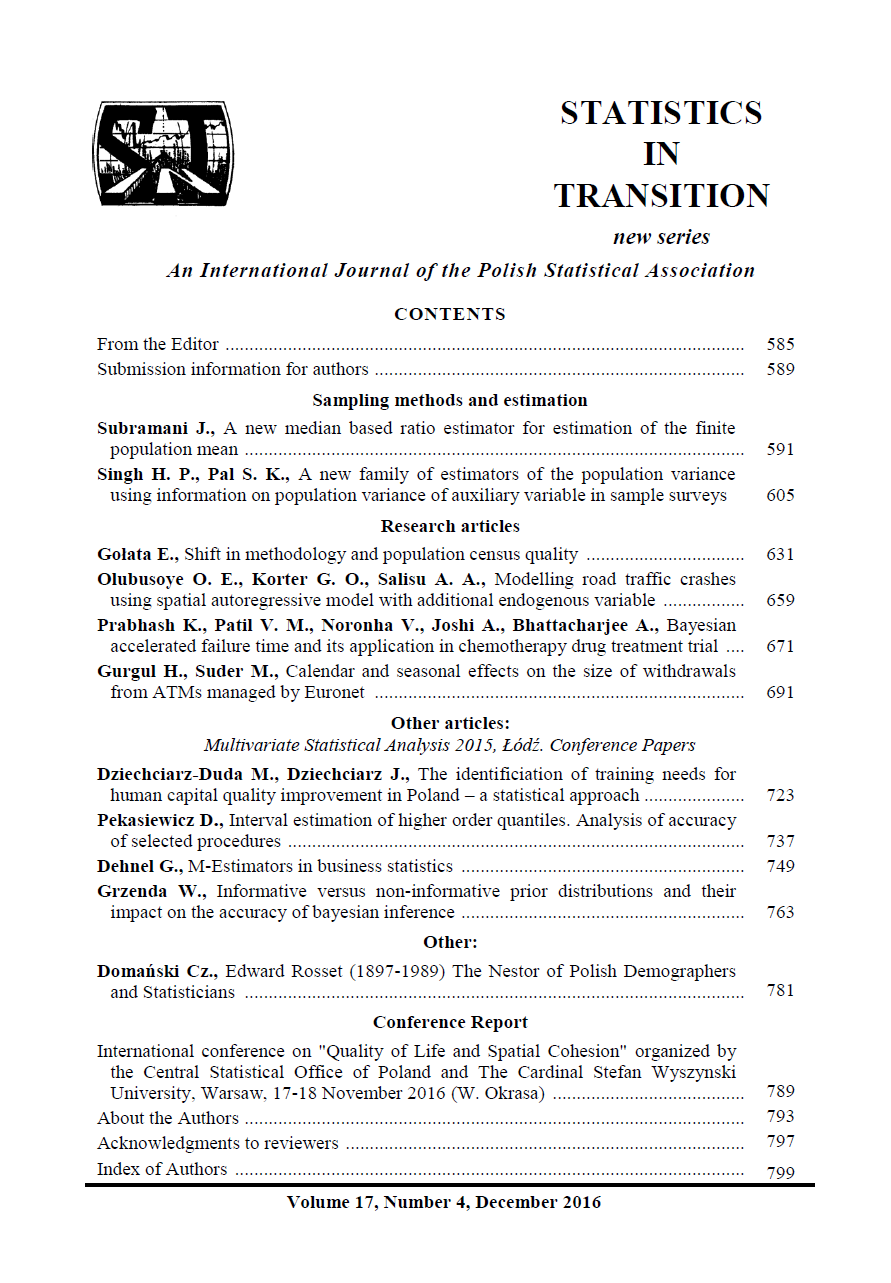ARTICLE
ABSTRACT
This study analyses the calendar effects on withdrawals from Automated Teller Machines (ATMs) (daily data) managed by the Euronet network for the period from January 2008 to March 2012. Our study focuses on the identification of specific calendar and seasonal effects in the ATM cash withdrawal series of the company in the Polish provinces of Małopolska and Podkarpackie. The results of the analysis show that withdrawals depend strongly on the day of the week. On Fridays more cash is withdrawn than on other days, and Saturdays and Sundays are the days of the week with the lowest level of withdrawals. In a month, it can be seen that cash withdrawals take place more often in the second and in the last weeks of the month. This observation suggests that withdrawals from ATMs can be related to the profile of wage withdrawals. In Poland, in the public sector wages are paid at the beginning of the month, and in the private sector at the end of the month. The time series of withdrawals also reflect seasonality. The largest amounts are withdrawn in July, August and December. Reason for the increased demand for cash are the summer holidays and the Christmas season. The results reflect consumer habits which show pronounced calendar and seasonal effects.
KEYWORDS
calendar effects, seasonal effects, replenishment management.
REFERENCES
BELL, W. R., HILLMER, S. C., (1983). Modeling Time Series with Calendar Variation. Journal of the American Statistical Association 78, pp. 526–534.
CARLSEN, M., STORGAARD, P. E., (2010). Dankort withdrawals as a timely indicator of retail sales in Denmark, Danmarks Nationalbank Working Papers, No. 66.
CLEVELAND, W. S., DEVLIN, S. J., (1980). Calendar Effects in Monthly Time Series: Detection by Spectrum Analysis and Graphical Methods. Journal of the American Statistical Association, 371, 75, pp. 487–496.
CLEVELAND, W. P., GRUPE, M. R., (1983). Modeling time series when calendar effects are present. Applied Time Series Analysis of Economic Data, Zellner, A. (editor), U.S. Department of Commerce, U.S. Bureau of the Census, Washington D. C., pp. 57–67.
DURATE, C., RODRIGUES, P., RUA, A., (2016). A Mixed Frequency Approach to Forecast Private Consumption with ATM/POS Data, International Journal of Forecasting (forthcoming)
ESTEVES, P. S., (2009). Are ATM/POS Data Relevant When Nowcasting Private Consumption?, Banco de Portugal Working Paper, 25.
FINDLEY, D. F., MONSELL, B. C., (2009). Modeling Stock Trading Day Effects Under Flow Day-of-Week Effect Constraints. Journal of Official Statistics, Vol. 25 (3), pp. 415–430.
FINDLEY, D. F., MONSELL, B. C., BELL, W. R., OTTO, M. C., CHEN, B. C., (1998). New capabilities and Methods of the X-12-ARIMA seasonal adjustment program. Journal of Business & Economic Statistics, Vol. 16 (2), pp. 127–77.
FINDLEY, D. F., SOUKUP, R. J., (1999). On the Spectrum Diagnostics Used by X-12-ARIMA to Indicate the Presence of Trading Day Effects after Modeling or Adjustment. Proceedings of the American Statistical Association, Business and Statistics Section, pp. 144–49.
FINDLEY, D. F., SOUKUP, R. J., (2000). Modeling and Model Selection for Moving Holidays. Proceedings of the American Statistical Association, Business and Economics Statistics Section, pp. 102–07.
FINDLEY, D. F., SOUKUP, R. J., (2001). Detection and Modeling of Trading Day Effects, in ICES II: Proceedings of the Second International Conference on Economic Surveys, pp. 743–53.
GALBRAITH, J. W., TKACZ, G., (2007). Electronic Transactions as High Frequency Indicators of Economic Activity. Bank of Canada Working Paper, 2007–58.
GERDES, G. R., WALTON, J. K., LIU, M. X, PARKE, D. W., (2005). Trends in the Use of Withdrawal Instruments in the United States. Federal Reserve Bulletin 91 (Spring), pp. 180–201.
HANSEN, P. R., LUNDE, A., NASON, J.M., (2005). Testing the Significance of Calendar Effects. Working Paper 2005-2, Federal Reserve Bank of Atlanta.
HOLDEN, K., EL-BANNANY, M., (2004). Investment in information technology systems and other determinants of bank profitability in the UK, Applied Financial Economics, 14, pp. 361–5.
KONDO, K., (2011). Do ATMs influence bank profitability in Japan? Applied Economics Letters, 2010, 17, pp. 297–303
KUFEL, T., (2010). Ekonometryczna analiza cykliczności procesów gospodarczych o wysokiej częstotliwości obserwowania, [Econometric analysis of the cyclical nature of economic processes with high frequency data], Wydawnictwo Naukowe Uniwersytetu Mikołaja Kopernika, Toruń.
KUMAR, S., KUMAR, D.K.S., (2014). ATM Usage Price in India, IUP Journal of Operations Management, Vol. 13, Issue 3, pp. 65–72.
LIU, L. M., (1980). Analysis of Time Series with Calendar Effects. Management Science 26, pp. 106–112.
MCELROY, T. S., HOLLAND, S., (2005). A Nonparametric Test for Assessing Spectral Peaks. Research Report 2005-10, Statistical Research Division, U.S. Bureau of the Census, Washington D. C.
RODRIGUES, P., ESTEVES, P., (2010). Calendar effects in daily ATM withdrawals. Economics Bulletin, vol. 30, No. 4, pp. 2587–2597.
SCHMITZ, S., WOOD, G., (2006). Institutional Change in the Withdrawals System and Monetary Policy. Routledge London.
SIMUTIS, R., DILIJONAS, D., BASTINA, L., (2008). Cash demand forecasting for ATM using Neural Networks and support vector regression algorithms. 20th International Conference, EURO Mini Conference, “Continuous Optimization and Knowledge-Based Technologies” (EurOPT- 2008), Selected Papers, Vilnius May 20-23, pp. 416–421.
SNELLMAN, H., VIREN, M., (2009). ATM networks and cash usage. Applied Financial Economics, 19 (10), pp. 841–851.
SULLIVAN, R., TIMMERMANN, A., WHITE, H., (2001). Dangers of Data Mining: The case of calendar effects in Stock Returns. Journal of Econometrics, 105, pp. 249–286.
TAKALA, K., VIREN, M., (2007). Impact of ATMs on the Use of Cash. Communications and Strategies, No. pp. 66, 47–61.
YOUNG, A.H., (1965). Estimating Trading-day Variation in Monthly Economic Time Series. Technical Paper 12, Bureau of the Census
